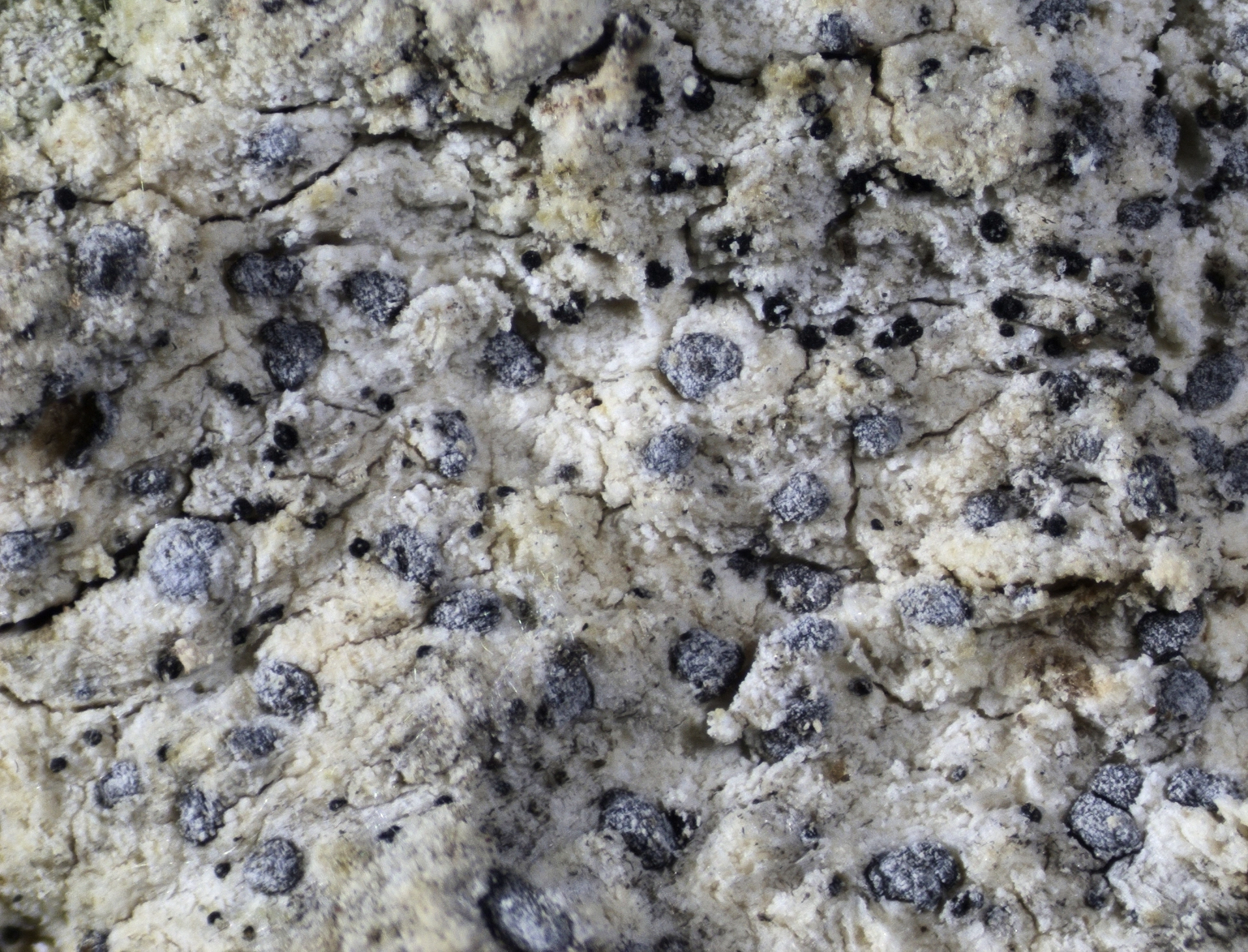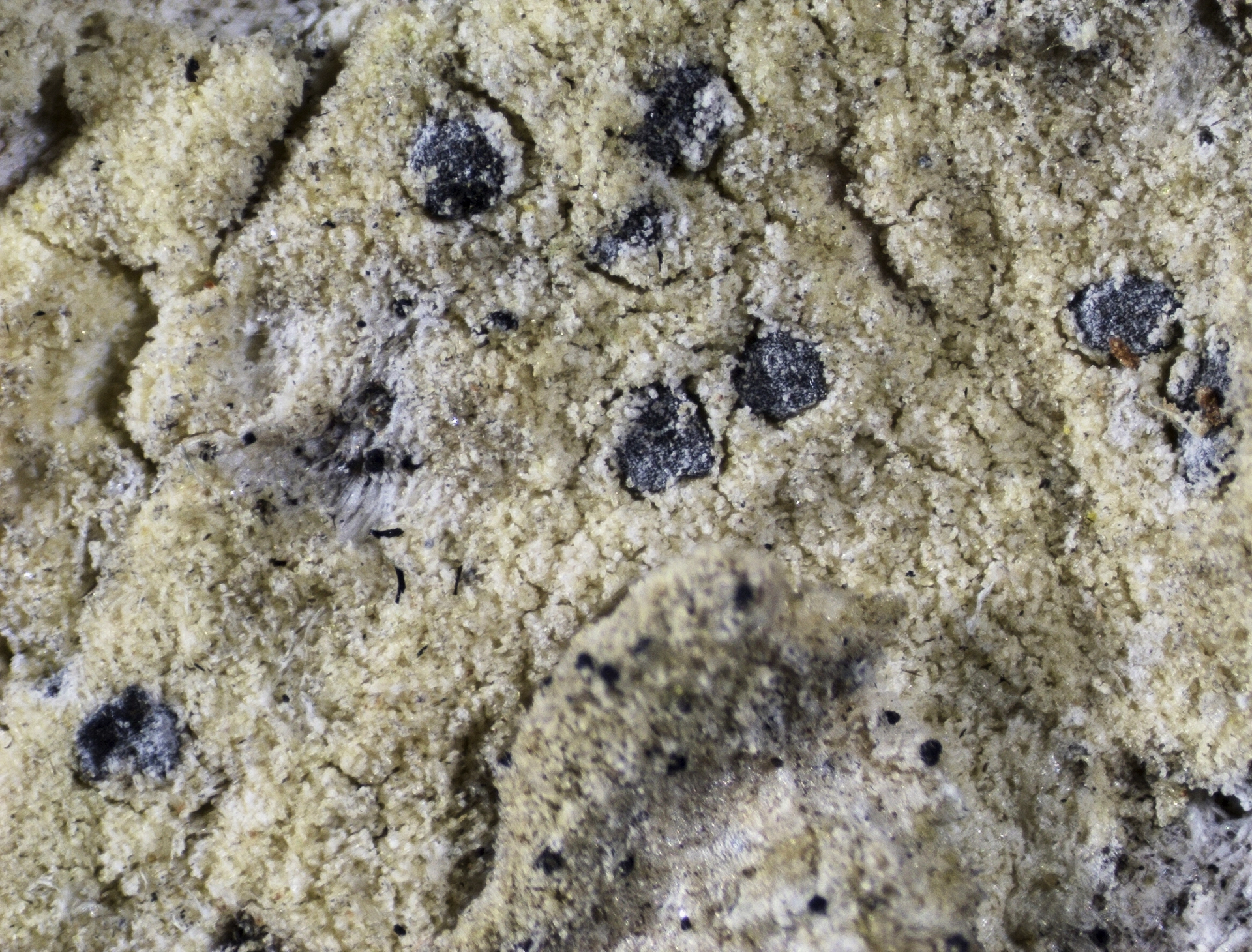Leprantha cinereopruinosa
Leprantha cinereopruinosa collected from an old Quercus sp. at Nordre Raumyrstykket in Drangedal (O-L-46247).
Leprantha cinereopruinosa is a rare species on old oak and linden trees in Telemark og Vestfold. It is characterized by a pale olive grey, PD+ orange thallus with numerous dark brown to black pycnidia. The apothecia are covered in a thin grey pruina. The spores are (2–)3–4(–5)-transversely septate, and pale brown and warted when old. The apical cell is not enlarged.
- Innhold
- Description
- Ecology
- Distribution in Norway and the Nordic countries
- Global distribution
- Similar species
- Remarks
Description
Thallus
The extensive thallus is pale olive grey, continuous to cracked, and has a smooth, matt or powdery surface. It is up to 0.1 mm thick and grows partly on the surface of the bark. The margin is not determinate or delimited by a thin brown line. The photobiont is a species of the family Trentepohliaceae.
Fruitbodies
The apothecia are level with the thallus surface or raised, rounded in shape, and dark brown to black beneath a thin grey pruina. They are 0.2–1 mm in size and 100–160 μm tall. The disc is slightly convex.
The epithecium is 10–15 μm tall, brown to reddish brown, and inspersed with pale granular crystals.
The hymenium is colorless and 40–60 μm tall.
The hypothecium is unpigmented or a reddish brown, and it is 50–90 μm tall.
The paraphysoids are 1–1.5 μm wide and richly branched. Their tips are mainly perpendicular to the surface, partly free, and slightly widened to 2–3 µm. Dark brown pigment plaques are often deposited on the outer walls.
The asci are obovoid to broadly clavate, with or without stipe, 33–42 × 15–22 μm in size, and 8-spored.
The spores are colorless, narrow obovoid, 11–17 × 4–6 μm in size, and have (2–)3–4(–5) transverse septa. The apical cell is not enlarged. Old spores are pale brown and warted.
Anamorph
The pycnidia are common and are often the only spore-producing structures. They are dark brown to black, either immersed in the thallus or slightly raised, and 0.1–0.3 mm in size. The wall is reddish brown. The conidia are 3–6 × 1–1.5 μm in size, rod-shaped, and straight.
Chemistry
The thallus reacts C–, K–, KC–, Pd+ yellow orange, UV–. Psoromic acid is detected by TLC.
The hymenium reacts first I+ blue then red, and KI+ deep blue. A KI+ blue ring structure is present in the tholus of the asci. Calcium oxalate crystals have not been observed.
The brown pigment in the epithecium and in the wall of the pycnidia changes to pale green in K solution.
Leprantha cinereopruinosa collected from Quercus sp. at Preikestolkollane in Drangedal (O-L-132303).
Ecology
Leprantha cinereopruinosa is a temperate species that typically grows on dry, rough bark of old deciduous and coniferous trees including fir (Abies spp.), linden (Tilia spp.), Norway spruce (Picea abies), and oak (Quercus spp.). It preferably occupies the shady inner parts of humid natural to old-growth forests. Leprantha cinereopruinosa has become increasingly rare in most parts of its distribution range and is largely extinct from central Europe.
In Norway, L. cinereopruinosa has mainly been found on old oak (Quercus spp.) trees in oak and spruce dominated forests, but also on linden (Tilia spp.) in linden dominated forest.
Distribution in Norway and the Nordic countries
Leprantha cinereopruinosa occurs in a small area near Skien in Telemark og Vestfold. In the Nordic countries, it is further known from southern Sweden.
Global distribution
Leprantha cinereopruinosa is widespread in temperate Europe, but largely absent from highly oceanic regions and the Mediterranean basin. It has also been found in eastern North America.
Leprantha cinereopruinosa collected from a large Tilia cordata at Middagskollen in Larvik (O-L-135877).
Similar species
Even in the absence of apothecia, Leprantha cinereopruinosa is a distinctive species by the extensive, pale olive grey thallus that reacts PD+ yellow orange and that bears numerous small, black, largely immersed pycnidia with small rod-shaped conidia. It cannot easily be confused with any other lichen in Norway.
Remarks
Leprantha cinereopruinosa is often found without apothecia in Norway. All findings have been made from 1988 onwards. Due to the frequent lack of apothecia, the species may have been overlooked and should be searched for in suitable habitats in southern Norway.
Literature
Sundin R (1999). Phylogenetic and taxonomic studies within Arthonia Ach. (Ascomycetes, Arthoniales). Botaniska institutionen, Stockholms universitet, Stockholm.
Wirth V, Hauck M and Schultz M (2013). Die Flechten Deutschlands, vol. 1+2. Ulmer, Stuttgart. 1244s.


